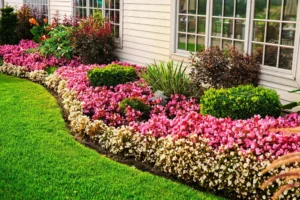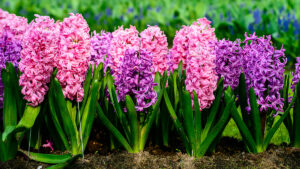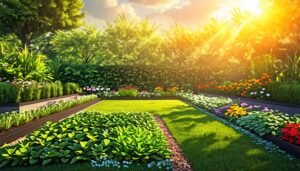Start Your First Vegetable Garden: A Complete Guide for Beginners
Are you dreaming of juicy tomatoes, crisp lettuce, and flavorful herbs grown right in your backyard? Starting your first vegetable garden is a rewarding journey that connects you with nature, saves money on groceries, and provides the freshest possible produce for your table. According to the National Gardening Association, home gardeners can expect to yield about $600 worth of produce from a well-planned garden costing just $70 to start.
In this comprehensive guide, we’ll walk you through everything you need to know to start your first successful vegetable garden in the United States, from planning and preparation to harvesting and enjoying your homegrown bounty.
Why Start a Vegetable Garden?
Before digging into the how-to, let’s explore why vegetable gardening has become increasingly popular across the United States:
- Superior taste and nutrition: Homegrown vegetables are harvested at peak ripeness, maximizing both flavor and nutritional value
- Cost savings: According to the USDA, growing your own vegetables can reduce your grocery bill by $500-$1,000 annually
- Environmental benefits: Reducing food miles and packaging waste while increasing biodiversity
- Physical activity: Gardening burns between 200-400 calories per hour while strengthening muscles and improving flexibility
- Mental health: Studies show gardening reduces stress hormones and increases serotonin, improving overall wellbeing
- Food security: Direct access to fresh produce regardless of supply chain disruptions
Planning Your Garden: Location, Size, and Layout
Choosing the Perfect Location
Your garden’s success begins with selecting the right location. Most vegetables require:
- Sunlight: At least 6-8 hours of direct sunlight daily
- Water access: Proximity to a water source for easy irrigation
- Good drainage: Areas where water doesn’t pool after rain
- Protection: Some shelter from strong winds and harsh elements
According to the USDA Agricultural Research Service, proper sun exposure is the single most important factor for vegetable garden success. If your yard has limited sunny spots, prioritize sun-loving crops like tomatoes and peppers for those areas, while growing leafy greens in partly shaded locations.

Determining the Ideal Size
For first-time gardeners, starting small is key to success. The USDA Cooperative Extension Service recommends beginning with a garden no larger than 100 square feet (10′ x 10′). This size is manageable for beginners while still producing a significant amount of food.
Consider these factors when determining your garden size:
- Available time: Realistically assess how much time you can devote to garden maintenance
- Household size: Estimate how much produce your household will consume
- Experience level: Start small and expand as you gain confidence and skills
Selecting the Right Layout
Several garden layouts work well for beginners:
- Traditional rows: Familiar and straightforward, with plants arranged in parallel lines
- Raised beds: Excellent for poor soil conditions, providing better drainage and soil warming
- Square foot gardening: Maximizes space efficiency by dividing growing areas into 1′ x 1′ squares
- Container gardening: Perfect for limited space, patios, or balconies
The National Gardening Association reports that raised bed gardens produce about four times more vegetables per square foot than traditional row gardens while using 30% less water and significantly reducing weeding time.
Understanding Your Soil and Climate
Soil Testing and Preparation
Healthy soil is the foundation of a successful vegetable garden. The USDA Natural Resources Conservation Service recommends getting your soil tested before planting to determine:
- pH level (most vegetables prefer 6.0-7.0)
- Nutrient content and deficiencies
- Soil texture and composition
- Presence of contaminants (especially important in urban areas)
You can obtain soil testing kits through your local Cooperative Extension Service office. For more information, visit the USDA’s soil health resources at https://www.nrcs.usda.gov/resources/guides-and-instructions/soil-health-guides.
Once you understand your soil composition, you can amend it appropriately:
- Add compost to improve structure and fertility
- Incorporate lime to raise pH or sulfur to lower it
- Mix in organic matter to enhance microbial activity
Understanding Your Climate Zone
The United States spans multiple climate zones, each with distinct growing conditions. The USDA Plant Hardiness Zone Map divides the country into 13 zones based on average annual minimum winter temperatures.
Knowing your zone helps you:
- Select appropriate vegetables for your region
- Determine optimal planting times
- Plan for season extension strategies
You can find your hardiness zone by visiting the official USDA Plant Hardiness Zone Map at https://planthardiness.ars.usda.gov/.
Choosing What to Plant
Best Vegetables for Beginners
Some vegetables are more forgiving than others. For your first garden, consider these beginner-friendly options:
| Vegetable | Days to Harvest | Sunlight Needs | Water Requirements | Beginner Difficulty (1-5) | Special Notes |
|---|---|---|---|---|---|
| Lettuce | 30-45 | Partial | Moderate | 1 | Quick harvest, succession plant |
| Radishes | 20-30 | Full | Moderate | 1 | Fastest growing vegetable |
| Bush Beans | 50-60 | Full | Moderate | 2 | Nitrogen-fixing, productive |
| Zucchini | 40-50 | Full | Moderate | 2 | High yield from few plants |
| Cherry Tomatoes | 60-70 | Full | Moderate-High | 3 | More disease resistant than large tomatoes |
| Bell Peppers | 60-90 | Full | Moderate | 3 | Longer growing season |
| Carrots | 60-80 | Full | Moderate | 3 | Needs loose, stone-free soil |
| Cucumbers | 50-70 | Full | High | 3 | Trellising saves space |
Selecting Seeds vs. Transplants
As a beginner, you’ll need to decide whether to start plants from seeds or purchase young plants (transplants):
Seeds advantages:
- More variety options
- Cost-effective ($2-4 per packet versus $3-5 per plant)
- Satisfaction of growing from start to finish
Transplant advantages:
- Head start on growing season
- Higher success rate for challenging vegetables
- Immediate visual impact in your garden
The USDA recommends that beginners use a combination approach: starting easy-to-grow vegetables like beans, lettuce, and radishes from seed while purchasing transplants for longer-season crops like tomatoes, peppers, and eggplants.

Essential Tools and Materials
A well-equipped gardener needs relatively few tools to get started. The National Gardening Association estimates that first-time gardeners can acquire all necessary tools for under $200, with quality tools lasting many seasons.
Basic Tool Checklist
- Hand trowel: For planting and transplanting
- Garden spade: For digging and edging
- Garden fork: For turning soil and compost
- Hoe: For weeding and making furrows
- Pruners: For harvesting and trimming
- Watering can or hose: For irrigation
- Garden gloves: For hand protection
- Wheelbarrow or garden cart: For moving materials
Materials and Supplies
In addition to tools, you’ll need:
- Quality seeds or transplants: Purchase from reputable suppliers
- Compost and organic matter: For soil improvement
- Mulch: To conserve moisture and suppress weeds
- Fertilizer: Choose organic options for food safety
- Support structures: Trellises, cages, or stakes for climbing plants
- Plant markers: To identify what you’ve planted
Step-by-Step Planting Guide
When to Plant
Timing is critical for garden success. The USDA provides region-specific planting calendars through the Cooperative Extension Service. Generally, vegetables fall into two categories:
Cool-season crops (plant early spring or fall):
- Lettuce, spinach, kale
- Radishes, carrots, beets
- Peas, broccoli, cauliflower
Warm-season crops (plant after last frost):
- Tomatoes, peppers, eggplant
- Cucumbers, squash, melons
- Beans, corn, okra
Your local frost dates determine optimal planting times. Find your area’s first and last frost dates using the Old Farmer’s Almanac tool, which utilizes NOAA weather data: https://www.almanac.com/gardening/frostdates.
How to Plant
Follow these steps for successful planting:
- Prepare the soil: Remove weeds and loosen soil to a depth of 8-12 inches
- Add amendments: Incorporate compost and any needed soil corrections
- Create planting areas: Form rows, raised beds, or containers as planned
- Plant according to instructions: Follow seed packet or plant tag guidance for spacing and depth
- Water thoroughly: Ensure soil is moistened to root depth
- Label plantings: Mark varieties and planting dates
- Apply mulch: Cover soil with 2-3 inches of organic mulch
Maintenance and Care
Watering Wisely
Proper watering is essential for garden success. The EPA WaterSense program recommends these practices:
- Water deeply and infrequently rather than lightly and often
- Direct water to the soil, not the foliage, to prevent disease
- Water in the morning to reduce evaporation and fungal issues
- Consider drip irrigation or soaker hoses for efficiency
- Adjust watering based on rainfall, temperature, and plant growth stage
Most vegetables need about 1-1.5 inches of water per week from either rainfall or irrigation. For more information on water-efficient gardening, visit https://www.epa.gov/watersense/watering-tips.
Fertilizing for Growth
Plants need nutrients throughout the growing season. The USDA recommends:
- Apply balanced organic fertilizer at planting time
- Side-dress heavy feeders (tomatoes, corn) midway through growing season
- Use compost tea or fish emulsion for gentle, regular feeding
- Avoid over-fertilizing, which can harm plants and waterways
Managing Weeds and Pests
The USDA’s Integrated Pest Management (IPM) approach emphasizes prevention and minimal intervention:
Weed management:
- Mulch thoroughly to suppress weeds
- Hand-pull weeds when small
- Use hoe for larger areas
- Avoid deep cultivation that brings weed seeds to surface
Pest management:
- Inspect plants regularly
- Encourage beneficial insects with diverse plantings
- Remove pests manually when possible
- Use row covers for vulnerable crops
- Consider organic sprays as a last resort
For guidance on identifying and managing garden pests, consult the USDA’s National Agriculture Library resources: https://www.nal.usda.gov/pest-management.
Harvesting and Enjoying Your Bounty
When and How to Harvest
Proper harvesting maximizes both yield and flavor. According to the USDA Agricultural Research Service:
- Harvest in the morning when vegetables contain the most moisture
- Pick frequently to encourage continued production
- Use sharp, clean tools to avoid damaging plants
- Follow crop-specific harvesting guidelines
Preserving Your Harvest
When your garden produces more than you can eat fresh, consider preservation methods:
- Freezing: Quick and easy for most vegetables
- Canning: Requires specific equipment but offers long shelf life
- Dehydrating: Great for herbs and certain vegetables
- Cold storage: Root vegetables can be stored in cool, dark conditions
The National Center for Home Food Preservation offers comprehensive guidance on safe food preservation methods: https://nchfp.uga.edu/.

Troubleshooting Common Problems
Even experienced gardeners face challenges. Here’s how to address common issues:
- Yellowing leaves: Often indicates nutrient deficiency or overwatering
- Wilting plants: Check for underwatering, root issues, or disease
- Poor fruit set: May result from temperature extremes or inadequate pollination
- Stunted growth: Could indicate compacted soil, insufficient nutrients, or pest damage
The Cooperative Extension Service offers free diagnostic assistance through their Master Gardener programs in every state. Locate your local extension office at https://nifa.usda.gov/land-grant-colleges-and-universities-partner-website-directory.
Looking Ahead: Season Extension and Year-Round Growing
As you gain confidence, consider extending your growing season:
- Cold frames: Simple structures that protect plants from frost
- Row covers: Lightweight fabric that traps heat while allowing light
- Succession planting: Staggering plantings for continuous harvest
- Winter gardening: Growing cold-hardy crops during cooler months
Conclusion
Starting your first vegetable garden is a journey of discovery that connects you with your food in a profound way. By applying the principles outlined in this guide, you’ll be well on your way to enjoying the satisfaction of growing your own nutritious, delicious vegetables.
Remember that gardening is both a science and an art—each season brings new lessons and rewards. Begin small, learn continuously, and enjoy the process of becoming more self-sufficient through your garden.
With patience, observation, and care, your first vegetable garden will be just the beginning of a lifelong relationship with growing your own food.





